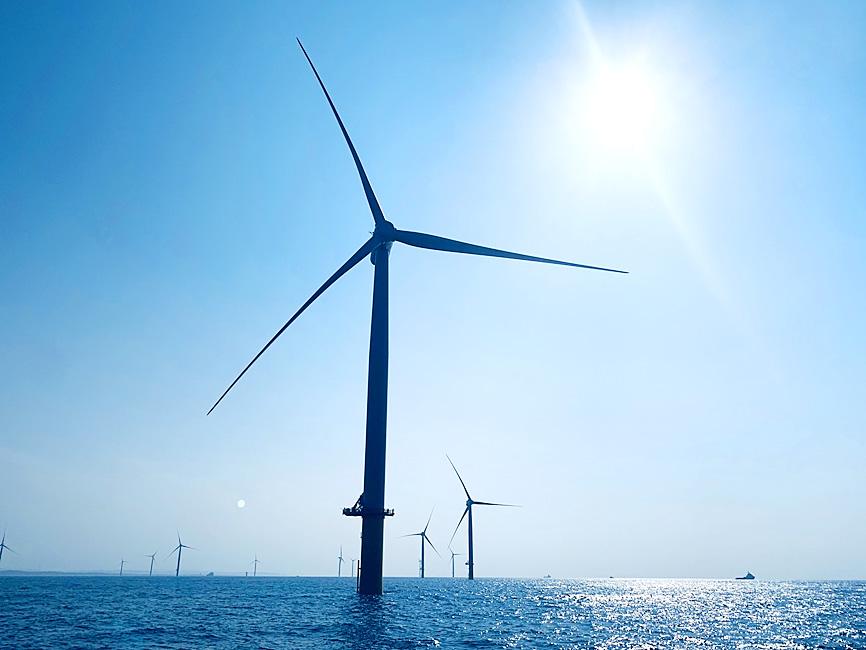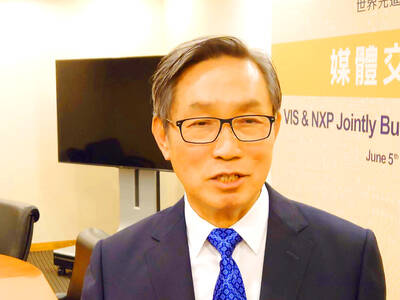After more than two years of negotiations with the Ministry of Economic Affairs, the 300 megawatt (MW) Hailong Offshore Wind 2A (海龍離岸風電) farm off the coast of Changhua County has finally come up with a plan that meets the ministry’s local content requirements.
Hailong’s developer Northland Power Inc, wind turbine manufacturer Siemens Gamesa Renewable Energy SA and ministry departments have had numerous meetings to figure out if and how the local supply chain can provide the 27 items that must be made locally for wind farms to qualify for the government’s higher feed-in-tariff rate.
Hailong has another 744MW of capacity it won in an auction that would not receive the favorable feed-in-tariff rate and is not subject to the localization requirements.

Photo: Lin Jing-hua, Taipei Times
“This has been a long journey, but we’ve been finally able to come to a consensus and it feels good to be finally able to start the project,” said Felipe Montero, head of Northland Power Taiwan and project director of Hailong Offshore Wind.
“Hailong looks forward to delivering on our localization commitments one by one,” the company said in a news release yesterday. “This will be an ‘anchor project’ that pushes forward the development of Taiwan into an export hub for the wind energy supply chain for the [Asia-Pacific] region.”
Hailong plans to work with partners Siemens Gamesa and CSBC-DEME Wind Engineering Co Ltd (台船環海風電) on the project.
“Hailong’s collaboration with CSBC-DEME was instrumental in bringing about Taiwan’s first domestic crane vessel, the Green Jade,” the release said. “With the ability to lift 4,000 [tonnes] using the latest DP3 [Dynamic Positioning 3] systems, the Green Jade will be finished by 2022 and start its service with the Hailong project.”
Hailong plans to use Siemens-Gamesa’s latest SG 14-222 DD 14MW turbines, and at 247m, they are one of the tallest turbines on the market, the release said.
The turbine “would be produced at Siemens-Gamesa’s nacelle assembly plant in Taichung harbor,” it said, adding that, apart from providing for domestic needs, Taichung would also become a regional export center.
Taiwan’s localization policy has been resisted by developers, who are mostly European.
They have said that the practice leads to cost overruns and there are not enough local suppliers that meet the exacting standards for making offshore wind turbine components.
Earlier this month, Cristina Lobillo Borrero, director for energy policy strategy and coordination at the European Commission, asked whether Taiwan’s local content policy might be in contravention of WTO rules.
She also said that the policy is bad for Taiwan’s energy users.
“Excessively strict demands regarding local content requirements would lead to higher costs, which would eventually be absorbed by consumers,” Borrero said.

TARIFFS: The global ‘panic atmosphere remains strong,’ and foreign investors have continued to sell their holdings since the start of the year, the Ministry of Finance said The government yesterday authorized the activation of its NT$500 billion (US$15.15 billion) National Stabilization Fund (NSF) to prop up the local stock market after two days of sharp falls in reaction to US President Donald Trump’s new import tariffs. The Ministry of Finance said in a statement after the market close that the steering committee of the fund had been given the go-ahead to intervene in the market to bolster Taiwanese shares in a time of crisis. The fund has been authorized to use its assets “to carry out market stabilization tasks as appropriate to maintain the stability of Taiwan’s

STEEP DECLINE: Yesterday’s drop was the third-steepest in its history, the steepest being Monday’s drop in the wake of the tariff announcement on Wednesday last week Taiwanese stocks continued their heavy sell-off yesterday, as concerns over US tariffs and unwinding of leveraged bets weighed on the market. The benchmark TAIEX plunged 1,068.19 points, or 5.79 percent, to 17,391.76, notching the biggest drop among Asian peers as it hit a 15-month low. The decline came even after the government on late Tuesday authorized the NT$500 billion (US$15.2 billion) National Stabilization Fund (國安基金) to step in to buoy the market amid investors’ worries over tariffs imposed by US President Donald Trump. Yesterday’s decline was the third-steepest in its history, trailing only the declines of 2,065.87 points on Monday and

TARIFF CONCERNS: The chipmaker cited global uncertainty from US tariffs and a weakening economic outlook, but said its Singapore expansion remains on track Vanguard International Semiconductor Corp (世界先進), a foundry service provider specializing in producing power management and display driver chips, yesterday withdrew its full-year revenue projection of moderate growth for this year, as escalating US tariff tensions raised uncertainty and concern about a potential economic recession. The Hsinchu-based chipmaker in February said revenues this year would grow mildly from last year based on improving supply chain inventory levels and market demand. At the time, it also anticipated gradual quarter revenue growth. However, the US’ sweeping tariff policy has upended the industry’s supply chains and weakened economic prospects for the world economy, it said. “Now

Six years ago, LVMH’s billionaire CEO Bernard Arnault and US President Donald Trump cut the blue ribbon on a factory in rural Texas that would make designer handbags for Louis Vuitton, one of the world’s best-known luxury brands. However, since the high-profile opening, the factory has faced a host of problems limiting production, 11 former Louis Vuitton employees said. The site has consistently ranked among the worst-performing for Louis Vuitton globally, “significantly” underperforming other facilities, said three former Louis Vuitton workers and a senior industry source, who cited internal rankings shared with staff. The plant’s problems — which have not